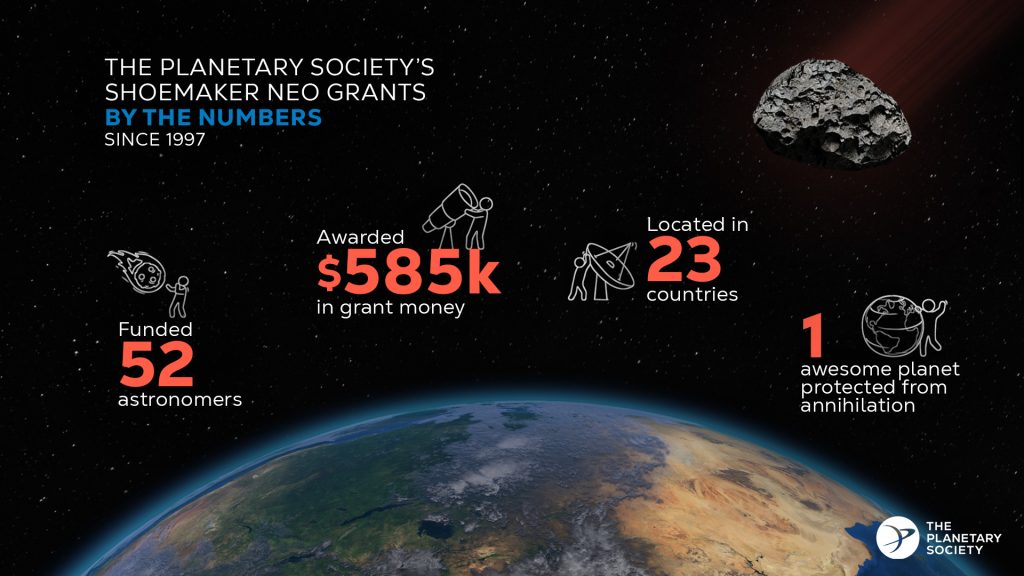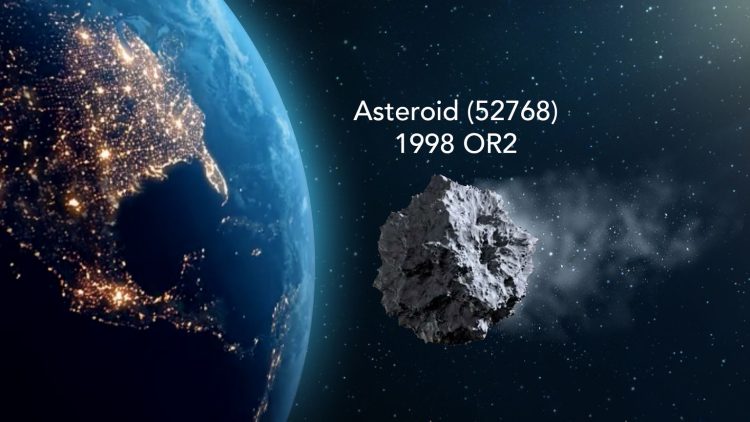The study of Near-Earth Objects (NEOs) has gained significant momentum in recent years, driven by a growing recognition of the potential risks and opportunities these celestial bodies present. The Shoemaker NEO Grant, a prestigious award dedicated to advancing NEO research and mitigation strategies, plays a pivotal role in supporting innovative projects and groundbreaking discoveries. This article provides an in-depth look at the latest updates from Shoemaker NEO Grant winners, exploring their research progress, achievements, and the broader implications for planetary defense and scientific understanding.
1. Introduction to the Shoemaker NEO Grant
The Shoemaker NEO Grant, established by The Planetary Society in honor of the late Dr. Eugene Shoemaker, is designed to foster research and innovation in the study of near-Earth asteroids and comets. Named after Dr. Shoemaker, a pioneering planetary geologist known for his work on impact cratering and cometary studies, the grant supports projects that enhance our understanding of NEOs, assess their potential threats, and develop mitigation strategies.
1.1 Objectives of the Grant
The primary objectives of the Shoemaker NEO Grant are:
- Advance Scientific Research: Support research that deepens our understanding of NEOs, including their composition, behavior, and impact potential.
- Improve Detection and Tracking: Fund projects that enhance our ability to detect and track NEOs, improving our preparedness for potential threats.
- Develop Mitigation Strategies: Support efforts to develop and test strategies for mitigating the risks posed by potentially hazardous NEOs.
1.2 Significance of NEO Research
NEOs, which include asteroids and comets that come close to Earth’s orbit, are of significant scientific and practical interest:
- Scientific Exploration: Studying NEOs provides insights into the early solar system and the formation of planetary bodies.
- Planetary Defense: Understanding NEOs is crucial for assessing and mitigating the risk of potential impacts on Earth.
- Resource Utilization: NEOs may contain valuable resources, such as metals and water, which could be utilized for future space missions and exploration.
2. Recent Updates from Shoemaker NEO Grant Winners
The Shoemaker NEO Grant has supported a diverse range of projects, each contributing to the advancement of NEO research and planetary defense. Here, we highlight some of the recent updates and achievements from grant recipients.
2.1 Advances in NEO Detection and Tracking
One of the primary focus areas for Shoemaker NEO Grant recipients is improving the detection and tracking of NEOs. Accurate tracking is essential for predicting potential impacts and planning mitigation strategies.
Recent Projects and Achievements:
- Enhanced Telescope Systems: Several projects have focused on upgrading and optimizing telescope systems for NEO detection. Innovations include new adaptive optics technologies and advanced imaging systems that improve the sensitivity and resolution of observations.
- Data Integration and Analysis: Efforts have been made to integrate data from multiple observatories and space missions, creating comprehensive databases of NEO observations. Advanced data analysis techniques, such as machine learning algorithms, are being employed to identify and characterize NEOs more effectively.
- Global Collaboration: Collaborative initiatives between international observatories and research institutions have expanded the network of NEO monitoring. These partnerships enhance the global capability to detect and track NEOs.
2.2 Research on NEO Composition and Structure
Understanding the composition and structure of NEOs is crucial for assessing their impact potential and exploring their resource potential.
Recent Projects and Achievements:
- Sample Analysis: Research teams have analyzed samples from NEO missions, such as NASA’s OSIRIS-REx and JAXA’s Hayabusa2, to gain insights into the composition and mineralogy of asteroids. These studies provide valuable information on the building blocks of the solar system.
- Laboratory Simulations: Laboratory experiments simulate NEO impact scenarios and material properties, offering insights into how different types of NEOs might interact with Earth’s atmosphere and surface.
- Radar Observations: Advanced radar systems have been used to study the surface features and internal structure of NEOs. These observations help scientists understand the physical characteristics and potential hazards of these objects.
2.3 Mitigation Strategies and Technology Development
Developing effective mitigation strategies is essential for reducing the risk posed by potentially hazardous NEOs. Recent projects have focused on innovative technologies and techniques for deflecting or disrupting NEOs.
Recent Projects and Achievements:
- Kinetic Impactors: Research into kinetic impactors, which involve launching high-speed spacecraft to collide with an NEO, has progressed. Simulations and tests are being conducted to evaluate the effectiveness of this approach in altering an NEO’s trajectory.
- Gravity Tractor Concepts: The concept of using a spacecraft to exert a gravitational force on an NEO, known as the gravity tractor method, is being explored. This technique involves positioning a spacecraft near the NEO to gradually change its course.
- Nuclear Disruption: Studies on nuclear disruption techniques, which involve detonating a nuclear device near or on an NEO, are ongoing. Researchers are evaluating the potential effects and safety considerations of this approach.

3. Case Studies of Recent Shoemaker NEO Grant Projects
To provide a deeper understanding of the Shoemaker NEO Grant’s impact, we examine several recent projects funded by the grant.
3.1 Project 1: The Next-Generation NEO Survey Telescope
Objective:
The project aims to develop and deploy a next-generation survey telescope equipped with advanced imaging and detection technologies.
Achievements:
- Telescope Design: The new telescope design incorporates cutting-edge adaptive optics and high-resolution imaging capabilities, enabling improved detection of smaller and fainter NEOs.
- First Light Observations: Initial observations have successfully identified several new NEOs and refined the tracking of known objects. The telescope’s data has been integrated into global NEO tracking databases.
Impact:
The project has significantly enhanced our ability to detect and monitor NEOs, contributing to more accurate impact predictions and risk assessments.
3.2 Project 2: Analyzing Asteroid Surface Properties with Radar
Objective:
This project focuses on using radar observations to study the surface features and internal structure of asteroids.
Achievements:
- Radar Imaging: High-resolution radar imaging has revealed detailed surface features and structural properties of several asteroids. These observations have provided insights into the composition and potential hazards of these objects.
- Impact Studies: Laboratory simulations of asteroid impacts have been conducted to understand how different types of asteroids might affect Earth’s atmosphere and surface.
Impact:
The project has advanced our understanding of asteroid structure and behavior, informing mitigation strategies and enhancing our ability to assess potential impact risks.
3.3 Project 3: Developing Kinetic Impactor Technology
Objective:
The project aims to develop and test kinetic impactor technology for deflecting NEOs.
Achievements:
- Prototype Testing: Successful tests of kinetic impactor prototypes have demonstrated the feasibility of altering an NEO’s trajectory using high-speed collisions.
- Simulation Results: Computer simulations have provided insights into the effectiveness of kinetic impactors under various scenarios and NEO characteristics.
Impact:
The project has made significant progress in developing practical deflection methods, contributing to planetary defense capabilities and future mission planning.
4. Broader Implications and Future Directions
The advancements made by Shoemaker NEO Grant winners have broad implications for planetary defense and scientific exploration. The insights gained from these projects contribute to our preparedness for potential threats and our understanding of the solar system.
4.1 Enhancing Planetary Defense
The progress in NEO detection, characterization, and mitigation technologies enhances our ability to defend Earth against potential impacts:
- Improved Risk Assessment: Accurate tracking and characterization of NEOs enable better risk assessments and early warning systems.
- Effective Mitigation: Advances in deflection technologies provide viable options for mitigating the risks posed by potentially hazardous NEOs.
4.2 Advancing Scientific Knowledge
The research supported by the Shoemaker NEO Grant contributes to our understanding of the solar system and the origins of planetary bodies:
- Solar System Formation: Studies of NEO composition and structure offer insights into the early solar system and the formation of planetary bodies.
- Asteroid Resources: Research into asteroid resources informs future exploration and potential utilization for space missions.
4.3 Inspiring Future Research
The success of Shoemaker NEO Grant projects inspires continued research and innovation in planetary science:
- New Technologies: Ongoing development of advanced technologies and methodologies will drive further discoveries and capabilities.
- Global Collaboration: International partnerships and collaborative efforts will enhance the effectiveness of NEO research and planetary defense.
5. Conclusion
The Shoemaker NEO Grant has played a crucial role in advancing our understanding of near-Earth objects and developing effective strategies for planetary defense. The recent updates from grant winners highlight significant achievements in detection, characterization, and mitigation, contributing to our preparedness for potential threats and our scientific knowledge of the solar system.
As we continue to explore and study NEOs, the insights gained from these projects will drive future research, technological advancements, and international collaboration. The ongoing efforts to enhance our capabilities in planetary defense and scientific exploration underscore the importance of supporting innovative research and fostering a deeper understanding of the cosmos.
Feel free to customize or add additional details as needed!


















































Discussion about this post